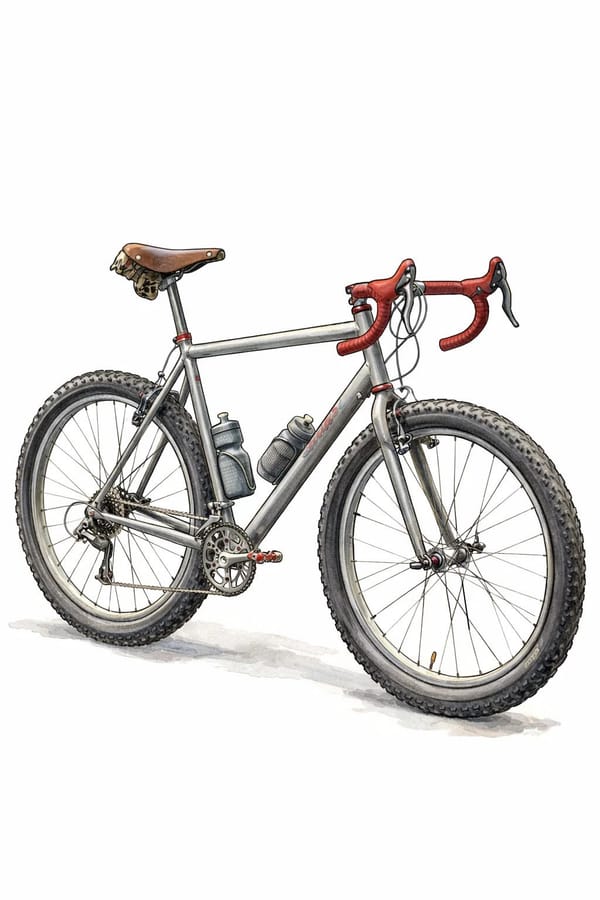Weekly Briefing - Taper Secrets, Vegan Power Myths, and UCI's New Speed Limits

Welcome to another edition of Gear & Grit, your weekly briefing on everything that matters in the world of cycling. It’s that time of year for many of us—the A-race, the big gran fondo, the event that’s been circled on the calendar for months. The hay is in the barn, but the nervous energy of the final week can make or break your performance. The urge to do one more hard ride is tempting, but it's a trap. This week, we’re dedicating our lead story to mastering the final countdown, transforming that nervous energy into a perfectly executed peak.
We’ll dive deep into the science and art of the taper, explaining why freshness trumps last-minute fitness. Then, we’ll unpack a groundbreaking nutrition study that challenges long-held beliefs about plant-based protein for athletes. We'll also break down the UCI's controversial new rules that are set to change the face of pro racing, explore the latest gravel gear trends that are borrowing heavily from the mountain bike world, and, as always, round up the best new gear, workouts, and podcasts to keep you informed and inspired. Let's get into it.
The Final Countdown: Mastering Your Race Week Taper
The final 7-10 days before a goal event are arguably the most critical and misunderstood period of any training plan. It’s a time when insecure athletes second-guess their preparation and try to cram, while confident athletes rest easy, knowing the work is done.The single most important principle to embrace is this: you will gain more from being fresh and rested than from anything you could add to your training within five days of your event.
The "Freshness over Fitness" Principle
Training is, by definition, a stressor. It causes short-term fatigue that temporarily suppresses performance. The only way to realize the full benefits of your months of hard work is to significantly reduce your training workload, allowing for physiological adaptation and complete recovery. This process lets your true fitness rise to the surface.With one week to go, your sustainable power over any duration is essentially fixed; no single workout is going to meaningfully boost your FTP or 5-minute power. The goal now is not to build fitness, but to shed the cumulative fatigue that is masking it.A successful taper is all about arriving at the start line feeling not just rested, but sharp, primed, and ready to perform.
Tapering vs. Recovery: A Critical Distinction
Many athletes mistakenly conflate a pre-race "taper week" with a "recovery week" that might fall in the middle of a training block. While both involve reduced training load, their objectives are fundamentally different. A mid-block recovery week is designed to absorb the stress of the preceding weeks, often through very low-intensity rides and complete rest days, allowing the body to adapt and build back stronger.
A pre-race taper, however, has a dual mandate: it must facilitate physiological recovery while maintaining neuromuscular sharpness. A week of nothing but easy, Zone 1 spinning will certainly leave you rested, but it can also result in feeling sluggish or having "flat legs" on race day. This happens because the high-speed communication pathways between your brain and muscles, which you've honed for explosive efforts, go dormant without stimulation.
The solution is to dramatically reduce training volume (total hours and miles) while strategically retaining small doses of intensity. These short, maximal-intensity efforts are not for building fitness; they are for keeping the engine primed and the nervous system firing efficiently. They ensure that when you demand a full-gas effort on race day, your body knows exactly how to respond.
Practical Taper Schedules
The ideal taper structure depends on the specific demands of your event. A criterium racer needs to preserve their explosive snap, while a gran fondo or gravel rider must protect their endurance. The following table provides sample schedules that balance volume reduction with targeted intensity.
Fueling the Taper
Proper nutrition during taper week is crucial for ensuring your muscles are fully loaded with glycogen for race day. However, the old-school, multi-day "pasta party" approach is often counterproductive, leading to bloating, digestive distress, and a feeling of lethargy.
A more effective strategy is to follow your final significant training ride (typically 7-10 days out) with a moderate increase in the proportion of carbohydrates in your diet for the 2-3 days leading into the event. This approach effectively tops off glycogen stores without overwhelming your system.
Equally important is staying on top of hydration. Chronic, low-level dehydration can build up over a week and significantly impair both performance and recovery. A simple and effective way to monitor your status is the WUT protocol: check your Weight, Urine color, and Thirst first thing in the morning. If two of the three indicators suggest dehydration (e.g., body weight is down, urine is dark, you feel thirsty), you likely need to increase your fluid intake throughout the day.
The Gravel Corner: Skills, Comfort, and the Latest Gear
Gravel continues its rapid evolution, carving out a distinct identity that blends the endurance of road cycling with the technical skill of mountain biking. This week, we look at the specific techniques for conquering loose climbs and the gear trends that are reshaping what a gravel bike can be.
Technique Deep Dive: Conquering Loose Climbs
Unlike road climbing, where success is primarily a function of power-to-weight ratio, climbing on loose gravel is often a battle for traction. The moment your rear wheel spins, momentum is lost, and frustration builds. Mastering this challenge requires a specific set of skills.
- Seated is King: On steep and loose sections, getting out of the saddle is often a recipe for disaster. Standing unweights the rear wheel, breaking traction. The most effective technique is to remain seated, keeping your weight firmly over the rear tire to maximize grip.
- Adopt the "Climbing Ready Position": To maintain traction on the rear wheel while preventing the front wheel from lifting or wandering, adopt a specific body posture. Hinge forward at the hips, lowering your chest towards the stem, and drop your elbows. You may also find it helpful to slide slightly forward on the saddle. This position keeps the front wheel planted for steering control while ensuring your center of mass remains over the rear wheel for power transfer and traction.
- Modulate Your Cadence: While high-cadence spinning is often efficient on pavement, on loose surfaces it can create jerky power delivery that breaks traction. Try shifting into a slightly harder gear and dropping your cadence to the 70-80 RPM range. This produces a smoother, more consistent torque that helps the tire bite into the surface rather than spin on top of it.
The Comfort Equation: Beyond the Bike Fit
On a long gravel day, comfort is speed. Reducing the fatiguing vibrations that travel from the ground to your body is one of the most effective ways to conserve energy and finish strong.
- Tire Pressure is Your First Suspension: The single most impactful adjustment you can make for comfort is optimizing your tire pressure. Higher pressure is not faster on rough surfaces. For a rider weighing around 150 lbs on 40c tires, pressures in the 25-35 psi range can dramatically smooth out the ride, improve traction, and reduce energy loss from bouncing over obstacles.
- Suspending the Rider, Not the Bike: A growing trend in gravel is the use of components designed to isolate the rider from impacts. Products like the Redshift Shockstop suspension stem and suspension seatposts absorb high-frequency vibrations and larger hits before they reach your hands and spine. This allows you to stay seated and pedal through rough sections where you might otherwise have to stand, saving considerable energy over the course of a long event.
- Long-Ride Body Care: For multi-day adventures or ultra-distance races, some unconventional wisdom from seasoned riders can be a game-changer. One such tip is to use an antiseptic cream (like Germolene or Brulidine) sparingly in place of traditional chamois cream. This can help prevent infection if micro-abrasions or saddle sores develop. Additionally, the habit of washing your bibs with biological detergent immediately after every ride, rather than letting them sit in a hamper, is crucial for preventing the buildup of bacteria that can lead to skin issues.
The Knowledge Hub: New Science & Pro Insights
Staying ahead of the curve means keeping up with the latest research and understanding the forces shaping our sport. This week, a new nutrition study challenges old dogmas, a training paper introduces a cutting-edge technique, and the UCI makes a move that will fundamentally alter pro racing.
Nutrition Newsflash: Plant-Based Power is Real
For years, a common concern among athletes considering a plant-based diet has been whether vegan protein sources can support muscle growth and repair as effectively as animal proteins. A new study highlighted this week provides a compelling answer.
Researchers found that when total daily protein intake is sufficient, the source of that protein may not matter. The study showed that both vegan and omnivorous diets produced similar rates of muscle protein synthesis, a key biological marker for a muscle-building state. This was supported by a separate 10-week trial where athletes consuming 1.6 g of protein per kilogram of body weight per day saw no meaningful differences in strength and muscle gains, regardless of whether their protein came from plants or animals.
The key takeaway is that athletes should focus on consistently hitting their total daily protein target—generally around 1.2 g/kg/day for maintenance and up to 1.6 g/kg/day for ambitious strength goals—rather than obsessing over the type of protein consumed in any single meal. This finding empowers athletes to choose a diet that aligns with their personal, ethical, or health preferences without fear of compromising their performance.
Training Science Update: Enhance HIIT with Blood Flow Restriction (BFR)
For time-crunched athletes, maximizing the adaptive signal from every workout is paramount. A new study published in the August 2025 issue of Medicine and Science in Sports and Exercise explores a novel way to amplify the benefits of high-intensity interval training (HIIT).
The study had participants perform HIIT cycling workouts, but one group had blood flow restriction cuffs applied to their legs during the rest periods between intervals. The results were striking: the BFR+HIIT group experienced significantly greater improvements in key endurance performance markers, including maximal aerobic power (Wmax) and time to exhaustion, compared to the group that performed HIIT without BFR. Critically, this enhanced adaptation occurred without any change in the perceived effort or pain of the workout itself.
This research suggests that BFR during rest periods could be a powerful tool for boosting training adaptations. It remains an advanced technique that requires proper equipment and knowledge, but it represents a fascinating new frontier in training efficiency.
Pro Peloton Shake-Up: UCI Imposes New Gear Limits
In a move that signals a major shift in the philosophy of professional cycling, the UCI has announced it will begin testing a 'Maximum Gearing' protocol in selected professional races starting August 1, 2025. The new rule will limit riders to a maximum gear equivalent to a 54x11 combination, which equates to 10.46 meters of distance covered per pedal revolution.
This decision comes directly from a recommendation by the SafeR Commission, an independent body focused on rider safety, which concluded that modern, ever-larger gear ratios are contributing to excessively high and dangerous speeds, particularly on descents.The rule will apply to mass start events but not time trials. It will most directly impact teams using SRAM groupsets, which commonly feature a 10-tooth small cog, requiring mechanical adjustments to comply.
This development is significant not just for its immediate impact on race tactics, but for what it represents in the broader context of the sport. For decades, the narrative in cycling technology has been a relentless arms race toward going faster, lighter, and more aero. This UCI rule is a rare, top-down intervention designed to deliberately reduce speed in the name of safety.
This move mirrors a bottom-up trend seen in the consumer gravel market, where riders are increasingly prioritizing control and safety through wider tires and suspension over pure, straight-line speed. Together, these developments suggest a potential inflection point for the entire cycling ecosystem. The long-held "speed at all costs" mentality is being challenged from multiple angles, potentially paving the way for future regulations (such as the proposed 65 mm rim depth limit) and a shift in how manufacturers market their products to a more safety-conscious consumer.
The Pain Cave: Smarter Indoor Training
Whether it's due to weather, time constraints, or a desire for structured precision, the indoor trainer is an indispensable tool. Here’s how to make your time in the pain cave more effective and engaging.
The 60-Minute Power Hour
For most amateur athletes juggling careers and families, long hours on the bike are a luxury. The good news is that highly structured, high-impact one-hour workouts can deliver significant improvements in endurance, FTP, and sprint power. Platforms like ROUVY and TrainerRoad have leaned into this reality, offering extensive libraries of curated 60-minute sessions that take the guesswork out of training and promise big returns for the time-crunched cyclist.
Workout of the Week: The 30/20/10 Drill
If you’re looking for a dynamic and brutally effective workout that builds power across multiple zones, look no further. This drill, which can be done for the duration of a high-energy song (4-5 minutes), is a favorite for its ability to push your limits and build mental toughness.
- Step 1: Begin by finding a cadence between 80-110 RPM. Your goal is to maintain this cadence range for the entire block.
- Step 2 (30 seconds): Set your resistance to a moderate gear, about a 6 out of 10 on a Rating of Perceived Exertion (RPE) scale.
- Step 3 (20 seconds): Without stopping, add a significant amount of resistance (e.g., two shifts on an electronic groupset) and increase your power output.
- Step 4 (10 seconds): Add even more resistance (e.g., another four shifts) and give a maximal, all-out sprint for 10 seconds.
- Step 5: Immediately drop the resistance back to your starting point (RPE 6/10) and begin the next 30-second interval. Repeat the cycle without rest until the block is complete.
What We're Listening To
The modern cyclist's interests are diverse, from the tactical nuances of a Grand Tour to the logistics of a solo bikepacking trip. This week's podcast releases reflect that breadth, and we've curated our top picks to match your passion.
For the Pro Tour Fanatic
- The Cycling Podcast: For unparalleled on-the-ground coverage of the Vuelta a España, you can't beat the daily episodes from Lionel Birnie and Daniel Friebe. Their latest dispatches offer analysis and atmosphere from (https://thecyclingpodcast.supportingcast.fm/listen) and the first mountain showdown in Andorra.
- Lanterne Rouge Cycling Podcast: If you crave deep-dive tactical breakdowns and data-driven analysis, Patrick Broe and Benji Naesen are essential listening. Their recent episodes breaking down theVuelta's team time trialand the sprint finish of(https://www.youtube.com/watch?v=hiKXh3OrMHs) provide insights you won't find anywhere else.
For the Gravel Adventurer
- The Gravel Ride: Host Craig Dalton's latest episode, "(https://thegravelride.bike/)," is a fantastic listen for anyone interested in the art and science of bikepacking gear. It’s a deep dive into the design philosophy of a beloved San Francisco-based bag maker.
- Girls Gone Gravel: Get a front-row seat at one of the biggest events on the gravel calendar with their new episode, "(https://podcasts.apple.com/us/podcast/girls-gone-gravel-podcast/id1506779235)." Kathryn and Kristi broadcast from the expo in Nebraska, capturing the pre-race buzz and interviewing top pros, including the race winner.





